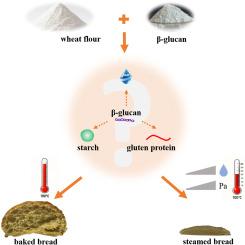在烤面包和馒头中添加β-葡聚糖的不同效果:解读BG的水合作用及其与淀粉-蛋白质网络的相互作用
IF 11
1区 农林科学
Q1 CHEMISTRY, APPLIED
引用次数: 0
摘要
混合连锁(1→3)(1→4)-β- d-葡聚糖(BG)因其在食品加工中的健康益处和独特的修饰作用而得到广泛认可。BG已被批准为一种理想的食品添加剂,以补偿在小麦面粉加工过程中发生的大量纤维损失。本研究采用两种不同的大麦品种(源自藏青2000的ZQ2000BG和源自藏青25的ZQ25BG)作为BG来源,系统地评估了BG在两种主要小麦产品(烤面包和馒头)中添加的不同效果。然后,通过综合分析BG理化性质的来源依赖性变化及其与面团关键成分(水、淀粉和蛋白质)的不同相互作用,阐明了其潜在机制。BG的加入对烤面包和馒头的影响明显不同,在烤面包中引起适度的面包体积膨胀,而在蒸面包中引起完全的结构崩溃。BG干扰淀粉和蛋白质的水合作用,可以直接与两者结合,对淀粉的糊化、消化和面筋蛋白中二硫键的形成有显著的抑制作用。BG的加入促进了面筋结构在烤面筋中形成更疏松、更细、更有弹性的面筋结构,而在蒸面筋中形成更厚、更没有弹性的面筋链。在馒头加热过程中的高湿、高压条件下,这种面筋破坏作用会加剧,最终导致结构完全破坏。此外,与ZQ25BG相比,zq2000bg具有更高的分子量、更低的(1→4)/(1→3)连锁比和多孔的微观结构,对α-淀粉酶样蛋白具有更强的结合亲和力,更明显的淀粉糊抑制作用和更好的烘焙面包性能。本文章由计算机程序翻译,如有差异,请以英文原文为准。

Divergent effects of β-glucan addition in baked vs steamed bread: Deciphering hydration of BG and its interaction with starch-protein networks
Mixed-linkage (1→3)(1→4)-β-D-glucans (BG) is widely recognized for its health benefits and distinct modification effects in food processing. BG has been approved as a desirable food additive to compensate for the substantial fiber loss that occurs during wheat flour milling. This study systematically evaluated the divergent effects of BG incorporation in two principal wheat-based products: baked bread and steamed bread, employing two distinct barley cultivars as BG sources (ZQ2000BG, derived from Zangqing2000; ZQ25BG, derived from Zangqing25). Then underlying mechanism was elucidated through comprehensive analysis of source-dependent variations in BG physicochemical properties and their distinct interactions with key dough components (water, starch, and protein). The incorporation of BG demonstrated markedly different effects on baked bread versus steamed bread, inducing modest loaf volume expansion in baked bread while causing complete structural collapse in steamed bread. BG interfered with the hydration of starch and proteins, and can bind directly to both components, exhibited significant inhibitory effects on starch pasting, digestion, and formation of disulfide bonds in gluten proteins. BG addition promoted the formation of a looser, finer, and more elastic gluten structure in baked bread dough, but led to thicker and less elastic gluten strands in steamed bread dough. Under the high-humidity, high-pressure conditions in steamed bread heating process, this gluten-disrupting effect becomes exacerbated, ultimately leading to complete structural failure. Furthermore, ZQ2000BG—characterized by higher molecular weight, lower (1→4)/(1→3) linkage ratio, and porous microstructure—demonstrated stronger binding affinity to α-amylase-like proteins, more pronounced starch pasting inhibition, and superior baked bread-making performance compared to ZQ25BG.
求助全文
通过发布文献求助,成功后即可免费获取论文全文。
去求助
来源期刊

Food Hydrocolloids
工程技术-食品科技
CiteScore
19.90
自引率
14.00%
发文量
871
审稿时长
37 days
期刊介绍:
Food Hydrocolloids publishes original and innovative research focused on the characterization, functional properties, and applications of hydrocolloid materials used in food products. These hydrocolloids, defined as polysaccharides and proteins of commercial importance, are added to control aspects such as texture, stability, rheology, and sensory properties. The research's primary emphasis should be on the hydrocolloids themselves, with thorough descriptions of their source, nature, and physicochemical characteristics. Manuscripts are expected to clearly outline specific aims and objectives, include a fundamental discussion of research findings at the molecular level, and address the significance of the results. Studies on hydrocolloids in complex formulations should concentrate on their overall properties and mechanisms of action, while simple formulation development studies may not be considered for publication.
The main areas of interest are:
-Chemical and physicochemical characterisation
Thermal properties including glass transitions and conformational changes-
Rheological properties including viscosity, viscoelastic properties and gelation behaviour-
The influence on organoleptic properties-
Interfacial properties including stabilisation of dispersions, emulsions and foams-
Film forming properties with application to edible films and active packaging-
Encapsulation and controlled release of active compounds-
The influence on health including their role as dietary fibre-
Manipulation of hydrocolloid structure and functionality through chemical, biochemical and physical processes-
New hydrocolloids and hydrocolloid sources of commercial potential.
The Journal also publishes Review articles that provide an overview of the latest developments in topics of specific interest to researchers in this field of activity.
 求助内容:
求助内容: 应助结果提醒方式:
应助结果提醒方式:


